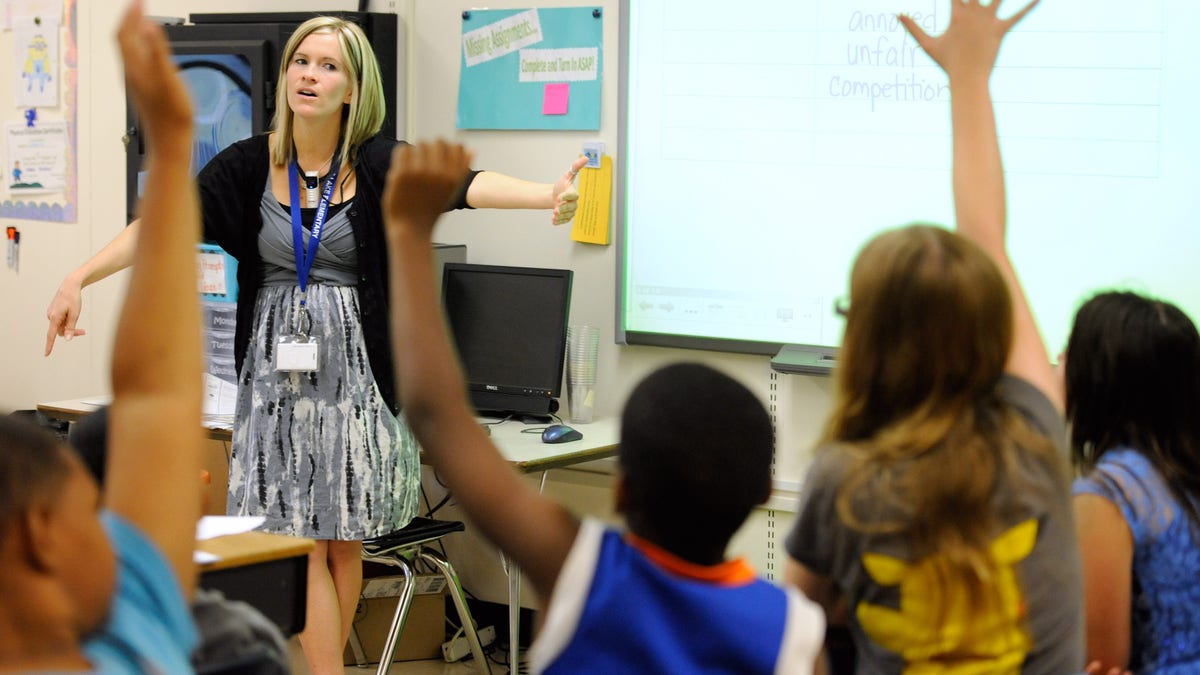
Amy Lawson, a fifth-grade teacher at Silver Lake Elementary School in Middletown, Del., teaches an English language arts lesson Tuesday, Oct. 1, 2013. The school has begun implementing the national Common Core State Standards for academics. (AP Photo/Steve Ruark) (The Associated Press)
Five years ago, 100Kin10, a network of over 200 partners, came together around a common goal: realizing President Obama’s challenge to train 100,000 high-quality science, technology, engineering and math (STEM) teachers by 2021.
President Obama recently announced that 100Kin10 will not only meet, but will exceed that goal by 2021.
As we celebrate this milestone and how far we’ve come over these five years, we still need to ask “What’s next?” How can we make even bolder progress and continue to value and invest in teachers?
As leaders at the intersection of STEM and education, we know that our country faces many systemic challenges in recruiting, training, supporting and retaining excellent STEM teachers.
We need creative solutions to manage the unreasonable load put on elementary teachers and to support meaningful, active STEM learning opportunities for students in their formative early years.
Just as businesses adapt operations to deal with high attrition rates, unprepared workers and to align with technological advancements and economic forecasts, we must act similarly by adapting to challenges in the classroom.
Working with hundreds of teachers, principals, education leaders and others, 100Kin10 has mapped these challenges and their root causes in order to activate and support teams of dedicated individuals and organizations across sectors who are committed to solving them.
We see a focus on the following three areas as key to making things better for STEM teachers:
1. Equip Teachers with the Right Support
Most elementary school teachers are generalists. Research shows they feel anxious about teaching STEM subjects and pressured to be experts in the field with little or no guidance. For almost all kids who go on to be STEM majors, their spark for science happens by third grade, so it’s crucial that elementary teachers are confident in STEM and able to kindle that spark.
We need creative solutions to manage the unreasonable load put on elementary teachers and to support meaningful, active STEM learning opportunities for students in their formative early years.
Our Fellowship Program, aimed at developing and piloting solutions to train and support elementary teachers, provides unprecedented collaboration from all of our partners. 100Kin10 delivers training and resources to our partners, who work with each other to ensure potential solutions are well-informed and on track for success before they are implemented.
2. Enhance Reputation and Recruitment
There is an ongoing challenge of recruiting undergraduates with strong STEM skills to become STEM teachers. In countries with higher performing students on international benchmarking tests, like PISA, teaching is a highly-esteemed and sought-after profession.
In the United States, teachers experience a significant pay gap compared to those in law, medicine or finance. The lack of compensation, and more importantly prestige around teaching, has created a culture where parents and even other STEM teachers often discourage their children and students from becoming STEM teachers – while encouraging them to pursue STEM careers outside of teaching.
With the economy rebounding and options for higher paying jobs more abundant, teaching applicants are dropping. According to federal data, there was a 30 percent drop in the number of people entering teacher preparation programs across the country from 2010 to 2014.
Alternative programs like Teach for America have experienced similar drops in recruitment the past few years.
Investing in teachers and improving the perception of teaching as being foundational to preparing students for global challenges is vital to attracting and retaining STEM teachers.
3. Increase Focus on Engineering and Computer Science
Engineering is critical in our 21st-century economy, but there’s a huge mismatch between what’s happening in K-12 schools and what our economy and society needs of its citizens and workers.
For students in most schools, there is very little applied science, math or computational thinking, even though we know that coding literacy is important and that a growing number of jobs will require computer science and engineering skills.
100Kin10’s partner programs, such as Engineering is Elementary (EiE) and Chevron-supported LinkEngineering.org, work to increase the reach and quality of engineering and computer science across K-12. For example, LinkEngineering.org ‑- a resource website for PreK-12 educators developed by the National Academy of Engineering -‑ provides examples of engineering in educational settings and background information on engineering and engineering design.
If we are to solve global challenges like water scarcity or finding a cure for cancer, we need the problem-solving power of our country’s greatest natural resource: its children.
Today, too many students, especially girls and students from underserved communities, never have the chance to bring their experience and expertise to bear because they lack critical STEM knowledge and skills.
All of us – from government to business to community organizations – are impacted, so we each have a unique stake in training our future and current STEM educators. Cooperation among our sectors toward that end will allow different kinds of resources, knowledge and expertise to come together around the common goal. One organization cannot make this happen alone.
In giving thanks to your teachers, don’t just bring them an apple. Join 100kin10 and Chevron in training STEM teachers and celebrating their role in preparing today’s students to be tomorrow’s innovators.
Talia Milgrom-Elcott is the co-founder and executive-director of 100Kin10.
Blair Blackwell is the manager of education and corporate programs for Chevron.
Chevron’s support of 100Kin10 is focused on investing in partnerships that prepare, retain, develop and motivate STEM professionals to achieve the 100Kin10 goal through collaboration.
